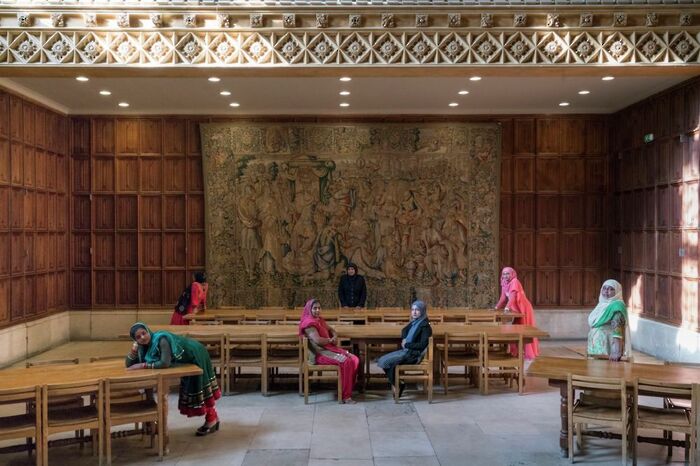The birth of futility: Auden and the old masters
As he views two paintings through the lens of Auden, Joseph Krol explores the feeling of futility in great art and its attribution

“About suffering they were never wrong, the old Masters…” How right Auden was. With these words, he opened his poem on Bruegel the Elder’s work Landscape with the Fall of Icarus (pictured above). The painting shows the famous myth of Icarus, who flew too close to the Sun, but it is depicted here only in a very secondary fashion – one can only just make out his legs thrashing in the bottom right. Elsewhere, in Auden’s words, “everything turns away / Quite leisurely from the disaster.” Even the greatest events, Bruegel seems to argue, are ignored by others; their lives are full of their own concerns. This futility, that even those who do something amazing will ultimately be forgotten, underpins many artworks down the centuries.
There are few places in Britain where the melancholic genius of these artists is clearer than the Fitzwilliam Museum. It has a fine collection of works, from the dawn of the Renaissance down to contemporary painters. Many of my favourite pieces in its collection hang in its Italian rooms, including an imposing work by Baroque artist Salvator Rosa titled L’umana fragilita (Human frailty).
“In an age when much art was almost mass-produced, this painting could not be more personal”
It is immediately arresting as one walks into the gallery. A vast winged skeleton takes up much of the upper half of the painting; it lunges down as it directs a child’s hand to write “conception is a sin, birth is pain, life is toil, death a necessity”. It does not, however, intend to shock through contrasts in colour; indeed, it is almost totally dominated by dull browns and greys. Rather, Rosa uses this apparently tedium to create a powerful sense of stifling inevitability and hopeless dread.
In an age when much art was almost mass-produced, this painting could not be more personal. Rosa created the work in the aftermath of a horrendous plague, which decimated his city of Naples in 1655. Almost all his relatives died, including his brother, his sister, all five of his nephews and nieces, and – most harrowingly – his son, Rosalvo. In a letter from the time, he describes how “this time heaven has struck me in such a way that shows me that all human remedies are useless”. The tenderly-drawn infants, the oppressiveness of death, the futility of life – all are desperate outpourings of grief onto the canvas.
For a man so convinced of the pointlessness of human endeavour, Rosa in himself seems to provide some semblance of self-contradiction. We are privileged as viewers to have both the artist’s works and his context: we admire his works, we know his biography, we try to understand his pains.

Not all artists have even this dignity. Almost all the earlier works in the collection, including many beautiful pieces of art, hang with a plaintive label: “Unknown artist, Italian school, c. 1400.” One can sometimes determine the city – Florence, Venice and Siena, for example, all had distinctive styles – but even so, the artists themselves are utterly unknown. In some cases, they are bestowed so-called ‘notnames’, often quite ridiculous: would one want to be known as the Master of the Female Half-Lengths, or as the Master of Embroidered Foliage? We do not know for certain when these artists lived, where they worked, or from what they took inspiration.
As it turns out, it is in this that the irony of Bruegel lies. A 1998 study showed beyond doubt that, in fact, the Landscape could not have been his work – the radiocarbon dating simply did not match up with the dates of his life. As such, the work is now thought to be that of a copyist working some years later. It hardly needs to be said that we have no idea who they were. The painter behind the work is as unknown and ignored as the Icarus he depicted – as the latter falls unremarked into the sea, so our artist has drowned in the ocean of memory’s oblivion.
But there is still some subtle solace: they are still capable of stirring our emotions half a millennium on. Perhaps we have lost context; by now we can never know. But it is a glorious property of great art that, regardless, its message can still be seen
 Features / Cloudbusting: happy 10th birthday to the building you’ve never heard of30 March 2025
Features / Cloudbusting: happy 10th birthday to the building you’ve never heard of30 March 2025 News / Uni offers AI course for Lloyds employees30 March 2025
News / Uni offers AI course for Lloyds employees30 March 2025 News / Caius clock hand returned nearly 100 years after student prank31 March 2025
News / Caius clock hand returned nearly 100 years after student prank31 March 2025 News / Hundreds of jobs to be cut at Cambridge University Hospitals1 April 2025
News / Hundreds of jobs to be cut at Cambridge University Hospitals1 April 2025 News / Ski mask-wearing teens break into Caius accommodation27 March 2025
News / Ski mask-wearing teens break into Caius accommodation27 March 2025





